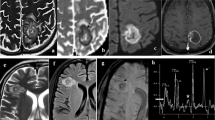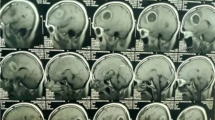Abstract
Cerebral phaeohyphomycosis is a rare fungal infection of man. There are approximately 53 published cases to date.Xylohypha bantiana has been shown by histology or culture to be the aetiological agent in 28 of these cases. Two cases of cerebral abscess caused byXylohypha bantiana are presented. One patient was alive eight months after surgery and antifungal drug therapy. His was the first recorded case of cerebral phaeohyphomycosis treated with itraconazole. His course was complicated by adhesive arachnoiditis. The second patient died post-operatively without appropriate treatment.
Similar content being viewed by others
References
Binford, C. H., Thompson, R. K., Gorham, M. E., Emmons, C. W. Mycotic brain abscess due toCladosporium trichoides, a new species. American Journal of Clinical Pathology 1952, 22: 535–542.
King, A. B., Collette, T. S. Brain abscess due toCladosporium trichoides: report of the second case due to this organism. Bulletin of the Johns Hopkins Hospital 1952, 91: 298–305.
Segretain, G., Mariat, F., Drouhet, E. SurCladosporium trichoides isolé d'une mycose cérébrale. Annales de l'Institut Pasteur 1955, 89: 465–470.
McGill, H. C., Brueck, J. W. Brain abscess due toHormodendrum species. Archives of Pathology 1956, 62: 303–311.
Watson, K. C., Lines, G. M. Brain abscess due to the fungusHormodendrum. South African Medical Journal 1957, 31: 1081–1082.
Manson, M. D. E. Chromoblastomycotic brain abscess in a South African Bantu. Report of a case. South African Journal of Clinical Medicine 1958, 4: 283–288.
Bobra, S. T. Mycotic abscess of the brain probably due toCladosporium trichoides: report of the fifth case. Canadian Medical Association Journal 1958, 79: 657–659.
Riley, O., Mann, S. H. Brain abscess caused byCladosporium trichoides. American Journal of Clinical Pathology 1960, 33: 525–531.
Horn, I. H., Wilansky, D. L., Harland, W. A., Blank, F. Neurogenic hypernatremia with mycotic brain granulomas due toCladosporium trichoides. Canadian Medical Association Journal 1960, 83: 1314–1317.
Symmers, W. S. C. A case of cerebral chromoblastomycosis (cladosporiosis) occurring in Britain as a complication of polyarteritis treated with cortisone. Brain 1960, 83: 37–51.
Duque, O. Meningo-encephalitis and brain abscess caused byCladosporium andFonsecaea. American Journal of Clinical Pathology 1961, 36: 505–517.
Watson, K. C. Cerebral chromoblastomycosis. Journal of Pathology and Bacteriology 1962, 84: 233–237.
Musella, R. A., Collins, G. H. Cerebral chromoblastomycosis. Journal of Neurosurgery 1971, 35: 219–222.
Bennett, J. E., Bonner, H., Jennings, A. E., Lopez, R. I. Chronic meningitis caused byCladosporium trichoides. American Journal of Clinical Pathology 1973, 59: 398–407.
Crichlow, D. K., Enrile, F. T., Memon, M. Y. Cerebellar abscess due toCladosporium trichoides (bantianum): case report. American Journal of Clinical Pathology 1973, 60: 416–421.
Middleton, F. G., Jurgenson, P. F., Utz, J. P., Shadomy, S., Shadomy, J. Brain abscess caused byCladosporium trichoides. Archives of Internal Medicine 1976, 136: 444–448.
Hironaga, M., Watanabe, S. Cerebral phaeohyphomycosis caused byCladosporium bantianum: a case in a female who had cutaneous alternariosis in her childhood. Sabouraudia 1980, 18: 229–235.
Sandhyamani, S., Bhatia, R., Mohapatra, L. N., Roy, S. Cerebral cladosporiosis. Surgery and Neurology 1981, 15: 431–434.
Kim, R. C., Hodge, C. J., Lamberson, H. V., Weiner, L. B. Traumatic intracerebral implantation ofCladosporium trichoides. Neurology 1981, 31: 1145–1148.
Seaworth, B. J., Kwon-chung K. J., Hamilton, J. D., Perfect, J. R. Brain abscess caused by a variety ofCladosporium trichoides. American Journal of Clinical Pathology 1983, 79: 747–752.
Chandramukhi, A., Ramadevi, M. G., Shankar, S. K. Cerebral cladosporiosis — a neuropathological and microbiological study. Clinical Neurology and Neurosurgery 1983, 85: 245–253.
Salaki, J. S., Louria, D. B., Chmel, H. Fungal and yeast infections of the central nervous system. A clinical review. Medicine 1984, 63: 108–132.
Kullu, S., Onol, B., Kustimur, S., Irkec, C., Ozbay, G. Cerebral cladosporiosis. Surgery and Neurology 1985, 24: 437–440.
Bhatia, R., Tandon, P., Misra, N. K. Inflammatory lesions of the basal ganglia and thalamus: review of twenty-one cases. Neurosurgery 1986, 19: 983–988.
Banerjee, U., Mohapatra, A. K., Sarkar, C., Chaudhery, R. Cladosporiosis (cerebral phaehyphomycosis) of brain — a case report. Mycopathologia 1989, 105: 163–166.
Rippon, J. W.: Culture media, media, stains, and serologic procedures. In: Rippon, J. W. (ed.): Medical mycology — the pathogenic fungi and pathogenicActinomycetes. Saunders, 1982, p. 772–795.
Rippon, J. W.: Chromoblastomycosis and related dermal infections caused by dematiaceous fungi. In: Rippon, J. W. (ed.): Medical mycology — the pathogenic fungi and pathogenicActinomycetes. Saunders, 1982, p. 267.
Padhye, A. A., McGinnes, M. R., Ajello, L., Chandler, F. W. Xylohypha emmonsii sp. nov., a new agent of phaeohyphomycosis. Journal of Clinical Microbiology 1988, 26: 702–708.
Rippon, J. W. The new opportunistic fungal infection: diagnosis, isolation, identification and impact on mycology. Mycopathologia 1987, 99: 143–146.
Van Cutsem, J., Van Gerven, F., Janssen, P. A. J. Activity of orally, topically, and parenterally administered itraconazole in the treatment of superficial and deep mycoses: animal models. Reviews of Infectious Diseases 1987, 9, Supplement 1: 15–32.
Ganer, A., Arathoon, E., Stevens, D. A. Initial experience in therapy for progressive mycoses with itraconazole, the first clinically studied triazole. Reviews of Infectious Diseases 1987, 9: 285–294.
Borelli, D. A clinical trial of itraconazole in the treatment of deep mycoses and leishmaniasis. Reviews of Infectious Diseases 1987, 9, Supplement 1: 57–63.
Author information
Authors and Affiliations
Rights and permissions
About this article
Cite this article
Heney, C., Song, E., Kellen, A. et al. Cerebral phaeohyphomycosis caused byXylohypha bantiana . Eur. J. Clin. Microbiol. Infect. Dis. 8, 984–988 (1989). https://doi.org/10.1007/BF01967570
Issue Date:
DOI: https://doi.org/10.1007/BF01967570




